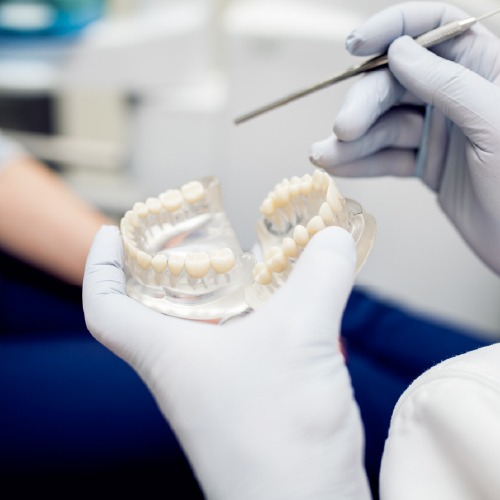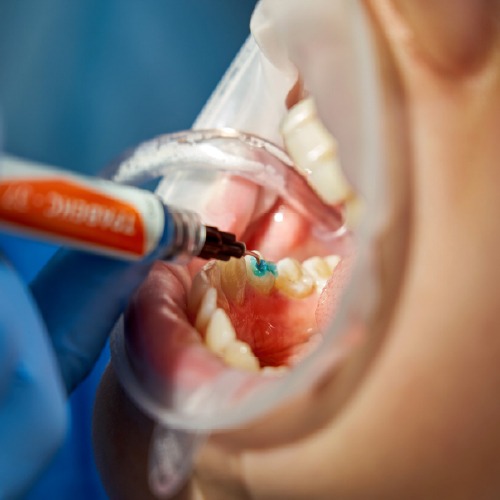All on 4 dental implant technique is a permanently fixed full-arch dental prosthesis with 4 dental implants placed per jaw, securely attached with a complete set of new teeth on one bridge that function like natural teeth to replace several missing teeth or an edentulous jaw caused by severely decayed teeth, periodontal disease, a serious accident, or alveolar bone loss, without the need to wear full dentures or undergo multiple dental implant surgeries.
All-on-4 dental implant technique is strategically designed to support the entire jaw with a single bridge, providing a newly pleasing smile within 1 day, allowing the tooth root to securely abut against the gums permanently, preventing loosened teeth due to bone loss, and restoring the full functioning force of biting, grinding, and chewing like natural teeth
Why All on 4 Dental Implant technique?
Because sometimes dentures are like that unreliable friend, they slip, slide, and embarrass you at dinner parties. All on 4 dental implant technique, on the other hand, is the superhero upgrade: 4 implants per jaw holding a full set of teeth so solid, you could probably open a bag of chips with them (though your dentist might not approve).
Whether your teeth bailed on you because of decay, cracks, breakage, or gum disease, All on 4 dental implant technique steps in with a cutting-edge design that fuses beautifully with your bone, no wobble, no fuss. The crowns look so natural, even your selfie camera won’t know the difference.
While dentures can turn chewing into a guessing game and give you that “grandparent whistle” while talking, the All-on-4 dental implant technique locks everything in place. You get back your bite, your chewing force, and your confidence without worrying about your smile staging a great escape.
Components of the All-on-4 Dental Implant technique
Think of All on 4 dental implant technique as a high-tech construction project for your smile, and like any good build, it comes with three essential parts:
- Implants (the foundation screws):
These little champs are the underground anchors, screwed snugly into your jawbone like nature’s version of heavy-duty bolts. They play the role of tooth roots, making sure your bridge doesn’t wobble, slip, or moonlight as a set of dentures. Bonus: they keep your jawbone upright so your face doesn’t start auditioning for a melted-candle look. - Abutments (the connectors):
Think of these as the “Lego pieces” that click everything together. They’re the middle managers of the system, linking implants below with the shiny new bridge above. Usually made of the same tough stuff as the implants, they keep everything compatible and drama-free. - Full-Arch Fixed Bridge (the showpiece):
This is the red-carpet part, your brand-new set of pearly whites. Designed with 3D digital wizardry and CAD/CAM magic, these crowns don’t just look natural; they chew, bite, and grind like the real deal. Usually crafted from porcelain (a.k.a. fancy ceramic), they’re strong, durable, and come with that perfect “natural-tooth glow”, no Instagram filter required.

What’s Better? A dental bridge vs an implant
Tooth loss is way more common than you might think. In fact, nearly 7 out of 10 adults between 35 and 44 are missing at least one tooth. Fast forward to age 74, and about one in four Americans are saying goodbye to all of their natural teeth.
When a tooth goes MIA, replacing it isn’t just about looks; it’s about keeping the rest of your smile in line, protecting your facial shape, and avoiding awkward chewing or speech struggles. The two most popular solutions? dental bridge vs implant.
- Dental bridges act like a tag team, using the teeth on either side of the gap to hold a false tooth (or several). They’re usually made of porcelain or other materials designed to blend in seamlessly with your smile.
- Dental implants are more like construction work, titanium “roots” surgically placed into your jawbone that serve as rock-solid anchors for a crown or bridge.
Both have their perks and drawbacks. So, let’s break down the pros and cons of dental bridge vs implant and figure out which option might be the real MVP for your smile.
dental bridge vs implant
Sure, both dental implants and bridges can give you a smile that looks so natural even your selfie camera will be fooled. But like any good showdown, each comes with its own set of strengths (and quirks). Let’s line them up side by side and see how these two contenders stack up in the battle of Tooth Replacement Champions.
Dental Bridge: The Quick Fix
Pros
- Friendly on the wallet (usually cheaper upfront than implants).
- Often covered by insurance (score!).
- No bone grafts or major surgery required.
- Done in just a couple of visits, quick smile glow-up in weeks, not months.
Cons
- Needs a redo every 5–7 years (if you’re lucky, maybe 10+).
- It can lose that “fresh, natural look” over time.
- Higher risk of cavities and decay in the neighboring teeth.
- It may damage the healthy teeth, holding them up like leaning on friends a little too much.
Dental Implant: The Long Game
Pros
- Can last 15+ years (the MVP of longevity).
- Keeps its natural look for the long haul.
- Leave your healthy teeth alone, no collateral damage.
- Boasts a whopping 97% success rate over 10 years.
Cons
- Pricier upfront, and insurance often gives it the cold shoulder.
- The process takes patience, sometimes up to 6 months.
- Surgery = potential complications (though rare).
So what do you choose, a dental bridge vs an implant?
If you’re after a quick, budget-friendly fix and don’t mind a little upkeep down the road, a dental bridge might be your best buddy. Think of it as the “fast food” of tooth replacement, quick, convenient, and gets the job done (just not forever).
But if you’re in it for the long haul, want something that looks and feels natural for decades, and don’t mind the upfront cost (or a bit of patience during healing), dental implants are the gold standard. They’re like the “forever home” for your smile.
At the end of the day, both can bring back your bite, your confidence, and your grin. The right choice depends on your budget, timeline, and whether you’d rather commit to a long-term solution or go with a quicker fix. Either way, your smile’s about to level up.
Are dental implants for diabetics a safe choice?
Not only are dental implants for diabetics a safe choice, but choosing permanent implants over dentures can actually support better overall health for people with diabetes.
dental implants for diabetics make it easier to maintain a balanced diet comfortably, while also reducing the inflammation, irritation, and infections that are more common with dentures or unhealthy teeth. Although diabetics may need special pre- and post-implant care to ensure the best results, recent studies confirm that dental implants for diabetics are safe and effective for those with well-controlled diabetes.
What are the benefits of dental implants?
Dental implant systems offer far more than just a way to replace missing teeth. There are so many benefits of dental implants. They restore your ability to chew and enjoy your favorite foods comfortably, while also bringing back a natural, attractive smile that boosts confidence. Unlike dentures, implants are securely anchored, so you don’t have to worry about slipping or shifting while eating or speaking.
Beyond aesthetics and functionality, the benefits of dental implants play a crucial role in maintaining oral health. They help prevent jawbone shrinkage that can occur after tooth loss and preserve the health of the surrounding bone and gums. By supporting the stability of adjacent teeth, implants also reduce the risk of misalignment and other dental problems that can arise when gaps are left untreated.
Overall, dental implants can significantly improve the quality of life. They allow you to eat, speak, and smile with confidence, while providing long-term benefits for oral health and facial structure. With proper care, implants offer a durable and reliable solution that can keep your smile strong and healthy for years to come.
Conclusion
All-on-4 Dental implant technique is more than just a cosmetic upgrade; they are a long-term solution for restoring both function and appearance after tooth loss. Unlike removable dentures, implants provide a stable, natural-looking set of teeth that allow you to chew, speak, and smile confidently. They not only enhance your appearance but also protect your jawbone, gums, and adjacent teeth, helping maintain overall oral health. For diabetics with well-controlled blood sugar, implants are a safe option that can even support better nutrition and reduce inflammation compared to traditional dentures.
By choosing the all-on-4 dental implant technique, you’re investing in a solution that improves your quality of life, preserves your facial structure, and offers durability for years to come. Whether you’re considering a single implant, multiple teeth replacement, or a full-arch system like All on 4 dental implant technique, implants combine strength, aesthetics, and long-term oral health benefits. With proper care and professional guidance, dental implants can restore your smile, confidence, and the ability to enjoy life fully.
References:
https://www.fda.gov/medical-devices/dental-devices/dental-implants-what-you-should-know
https://www.asird.org/are-dental-implants-safe-for-diabetics.
https://www.healthline.com/health/implant-vs-bridge#costs
https://www.medparkhospital.com/en-US/disease-and-treatment/all-on-4-dental-implants




